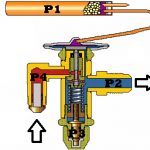Register now or log in to join your professional community.

before this expansion valve the pressure is very high and suddenly after this the pressure become very low and throttling affect stars which cause the refrigerant to evaporate without heat and it takes heat from its surrounding and cause cooling effect

As the thermostatic expansion valve regulates the rate at which liquid refrigerant flows into the evaporator, it maintains a proper supply of refrigerant by matching this flow rate against how quickly the refrigerant evaporates (boils off) in the evaporator coil. To do this, the TXV responds to two variables: the temperature of the refrigerant vapor as it leaves the evaporator (P1) and the pressure in the evaporator itself (P2). It does this by using a movable valve pin against the spring pressure (P3) to precisely control the flow of liquid refrigerant into the evaporator (P4):
TXV Pressure Balance Equation P1+P4 = P2+P3P1 = Bulb Pressure (Opening Force)P2 = Evaporator Pressure (Closing Force)P3 = Superheat Spring Pressure (Closing Force)P4 = Liquid Pressure (Opening Force)
P1+P4 = P2+P3P1 = Bulb Pressure (Opening Force)P2 = Evaporator Pressure (Closing Force)P3 = Superheat Spring Pressure (Closing Force)P4 = Liquid Pressure (Opening Force)

A thermostatic expansion valve is built up around a thermostatic element separated from the valve body by a diaphragm. A capillary tube connects the element to a bulb and a valve body with valve seat and a spring.
The function of a thermostatic expansion valve is determined by three fundamental pressures:
P1: Bulb pressure which acts on the upper surface of the diaphragm, in the valve opening direction.
P2: Evaporating pressure which acts on the underside of the diaphragm, in the valve closing direction.
P3: Spring pressure which also acts on the underside of the diaphragm, in the valve closing direction.
When the expansion valve regulates, balance is created between bulb pressure on one side of the diaphragm and evaporating pressure plus spring force on the other side.



